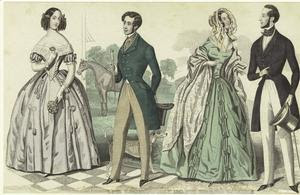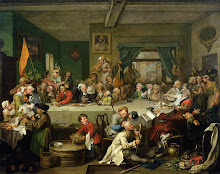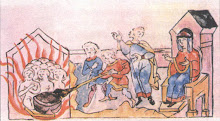"When a man makes up his mind without evidence, no evidence disproving his opinion will change his mind."
-Robert A. Heinlein
 The only likeness of Virginia Clemm Poe with any claims to authenticity is the famous "deathbed portrait," a watercolor presumably painted immediately after her death. Even this picture has a number of question marks surrounding it. The portrait--which was not made public until 1893--was said to be in the possession of her mother Maria Clemm, who evidently bequeathed it to the family of her relative Neilson Poe, which suggests it is genuine. However, we have no information about when and by whom the painting was done (there is no basis for the speculation that the portrait, which is obviously the work of a professional artist, was executed by Marie Louise Shew,) or whether the picture is even a good likeness.
The only likeness of Virginia Clemm Poe with any claims to authenticity is the famous "deathbed portrait," a watercolor presumably painted immediately after her death. Even this picture has a number of question marks surrounding it. The portrait--which was not made public until 1893--was said to be in the possession of her mother Maria Clemm, who evidently bequeathed it to the family of her relative Neilson Poe, which suggests it is genuine. However, we have no information about when and by whom the painting was done (there is no basis for the speculation that the portrait, which is obviously the work of a professional artist, was executed by Marie Louise Shew,) or whether the picture is even a good likeness.It would be odd if Virginia, who had grown very thin and slight during her long battle with tuberculosis, had been as facially plump as the girl in the portrait. The painting shows a young woman with hazel eyes, when the most reliable descriptions give Virginia's eyes as unusually large and very dark. Also, one of the few areas of consensus among Poe's contemporaries is that Virginia was very beautiful, even until the time of her death. The portrait depicts someone who, while pleasant-looking, could hardly be called lovely, or even noticeably pretty. It may be that this painting was not done from an "in-person" view of Virginia, but merely from a description of her provided to the artist.
Given the unsatisfactory nature of this portrait, it is not surprising that a number of attempts have been made to find a "from-life" image of Poe's wife. There are three pictures in particular that in recent years have often been presented as authentic portraits of Virginia. Unfortunately, there is no solid reason in the world to think they have any connection with her at all.
The first of these I discussed in an earlier post. It is one of three drawings that in 1930 were sold as artwork done by Poe himself. The sketches were immediately unmasked as forgeries, but that has not prevented them from having a surprisingly persistent circulation.
The second image is an oil painting of a young woman holding flowers that first surfaced in 1929. (It can be seen here.) It appeared as part of an art collection sold by the widow of an Englishman named Joseph Thomas Scott. Mrs. Scott claimed that he acquired the painting during a visit to the United States sometime in the 1870s, and that it "was always said to represent Virginia Clemm." Mrs. Scott had no documentation for this claim, and she wrote several letters dealing with this painting that are suspiciously contradictory in their details. (When Richmond's Poe Museum was invited in the 1930s to buy the portrait, they declined because of the impossibility of authenticating the work.) Later, it was suggested that the picture--which is unsigned--had been done by Thomas Sully.
Sully has a place all to himself in the incredibly large world of bogus Poe pictures. Poe was reputedly a boyhood friend of the artist's nephew, a less-talented painter named Robert Sully--although it should be noted Robert was six years Poe's senior, and nearly all we know about this "friendship" comes to us via Susan Archer Talley Weiss. However, there is no evidence that Poe and Thomas Sully even met. Art historian Michael Deas, in his book "The Portraits and Daguerreotypes of Edgar Allan Poe," noted that although Thomas Sully left an enormous amount of documentation about his life and work, including portrait registers, diaries, letters, and autobiographical manuscripts, Poe's name is never so much as mentioned in any of them. Poe himself left no known indication that he knew either of the Sullys, much less that he or his wife may have sat for either of them. Despite this, over the years a number of anonymous portraits of dark-haired men--most of which bear not the faintest resemblance to Poe--have been hopefully labeled as "Poe by Sully" artwork. (Deas devoted an entire section of his book to the long and strange history of faux Poe portraiture.) It is most likely that this "Virginia portrait" is merely a way of giving Poe's wife equal time in the spurious picture sweepstakes.
Some have thought the portrait is modelled after Sully's style, (which would not be surprising, as he was one of the most popular artists of his day,) but even that has been debated. The girl in the picture bears a vague general resemblance to the one in the "deathbed portrait" (although this oil painting is so stylized it is hard to be certain.) However, the lack of provenance for the painting, and the complete absence of any evidence linking it to either Poe or Sully, makes it impossible to put trust in its authenticity.
The third "Virginia portrait" (which can be seen here) surfaced only a few years ago, in the possession of a descendant of Virginia's cousin Elizabeth Herring. This portrait, as well, suffers from a complete lack of documentation, other than this descendant's unverifiable assertion that she had always been "told" it was of Virginia. It is--like the other two paintings--unsigned, and, except for a stamp on the back reading "Richmond, Virginia," unlabeled. It has been conjectured that the painting was done during the brief period Edgar and Virginia lived in Richmond, possibly by--inevitably--Thomas or Robert Sully. Again, we do not have a shadow of proof this is the case. The woman in the portrait does not bear much resemblance to either the "deathbed portrait" or the Joseph Thomas Scott painting, and she looks too mature to have been Virginia, who was only fourteen when she left Richmond for good in early 1837. It seems far more logical that the sitter is another relative, possibly Elizabeth Herring herself. (When Herring married in 1834, she moved to her husband's hometown in Virginia. It is not improbable that during her marriage, she went to Richmond to have her portrait done.)
In 1970, the auction house of Adam A. Weschler & Son, Inc. offered for sale a miniature painting by an unknown artist that was described as a portrait of Virginia Clemm. I have been unable to trace any other mention of this picture (Michael Deas seemed unaware of its existence,) which suggests its genuineness was also highly suspect.
What is also telling against the authenticity of these pictures is the simple fact that there is absolutely no contemporary evidence of any life portrait or daguerreotype of Virginia. In the years following Poe's death, as his legend grew, his biographers and other admirers were understandably eager to find images of his young and beautiful wife. Although their quest for pictures of Virginia was well-publicized, not one of her friends or relatives--including members of the Herring family (who had been contacted by many of these Poe collectors)--were able to offer anything other than the "deathbed portrait." And if either of the Sullys--or any other artist--did paint Virginia, why did they not sign any of these portraits? Why would they fail to leave any sort of documentation at all that they had the honor of creating an image of Poe's wife?
It is natural that Poe scholars would be anxious to uncover representations of the living Virginia. I'd love to see one myself. However, that cannot blind anyone to the fact that these pictures that have emerged--charming to look at as they are--simply cannot be treated as trustworthy likenesses.
A postscript: Undoubtedly, the strangest contribution to the list of dubious images of Virginia--indeed, one of the strangest contributions to Poe "scholarship" in general--was made by J.H. Whitty and Thomas O. Mabbott. (That pair managed, between them, to be responsible for an astonishing number of the loonier myths about Poe.) At some point in the early 20th century, Whitty came to fancy--no one has the slightest idea how--that Poe, his wife (and Mrs. Clemm!) modeled for "fashion plates" published in "Graham's Magazine." Mabbott, who had been something of a protégé of Whitty's (which explains a lot about him,) took up the idea, even though he could never decide which "Graham's" engraving he thought may contain likenesses of the trio. He also never succeeded in formulating a reason why he imagined Poe and his womenfolk had served as models, other than weak mutterings about "vague tradition" and "probability of appearance." (Even though, in the same breath, he said that "I am not sure we should call these things portraits.")
If there is anything that illustrates the generally pathetic state of Poe research, this is it. Whitty and Mabbott, two men who--Heaven knows why--are considered among the leading Poe scholars, invented out of thin air a story that is ludicrous on its face and that has absolutely no evidence to support it. There is no "tradition"--vague or otherwise--that the Poe household ever posed as antebellum centerfolds, and the wooden, generic figures depicted in the "Graham's" engravings do not even show the slightest resemblance to the trio, or anyone else for that matter. (An obviously bemused Michael Deas commented, "It is almost needless to add that Edgar and Virginia Poe would seem odd choices for fashion models.")
 When it is also considered that Poe is on record as stating that one of his main reasons for resigning from "Graham's" in 1842 was his "disgust" with the "namby-pamby character of the Magazine," calling particular attention to "the contemptible pictures, fashion plates, music, and love-tales" found therein, one has to wonder if Whitty and Mabbott were secretly staging a Poe-esque hoax on us all. Certainly, that is the kindest explanation of their actions.
When it is also considered that Poe is on record as stating that one of his main reasons for resigning from "Graham's" in 1842 was his "disgust" with the "namby-pamby character of the Magazine," calling particular attention to "the contemptible pictures, fashion plates, music, and love-tales" found therein, one has to wonder if Whitty and Mabbott were secretly staging a Poe-esque hoax on us all. Certainly, that is the kindest explanation of their actions.("Graham's" engraving that has nothing whatsoever to do with Poe: NYPL Digital Gallery)















